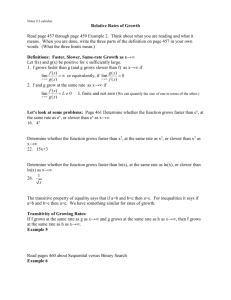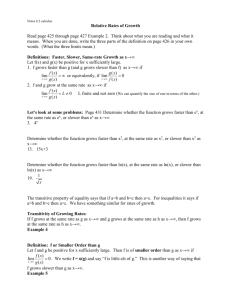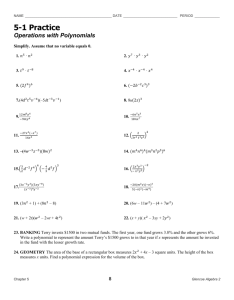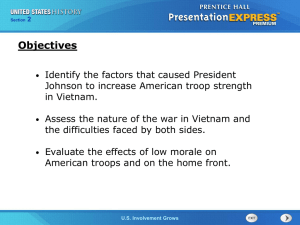RELATIVE RATES OF GROWTH It is often important to determine
advertisement
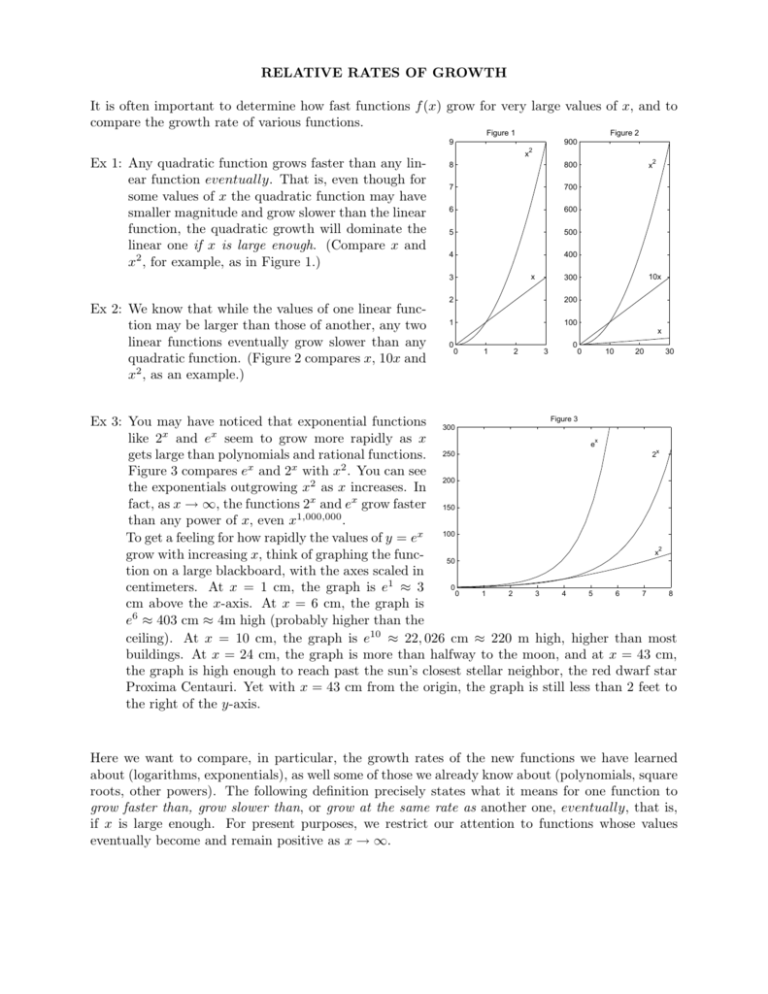
RELATIVE RATES OF GROWTH It is often important to determine how fast functions f (x) grow for very large values of x, and to compare the growth rate of various functions. Figure 1 Figure 2 9 900 2 Ex 1: Any quadratic function grows faster than any linear function eventually. That is, even though for some values of x the quadratic function may have smaller magnitude and grow slower than the linear function, the quadratic growth will dominate the linear one if x is large enough. (Compare x and x2 , for example, as in Figure 1.) x 8 800 7 700 6 600 5 500 4 400 x 3 Ex 2: We know that while the values of one linear function may be larger than those of another, any two linear functions eventually grow slower than any quadratic function. (Figure 2 compares x, 10x and x2 , as an example.) x2 10x 300 2 200 1 100 0 0 x 0 1 2 3 0 10 20 30 Figure 3 Ex 3: You may have noticed that exponential functions 300 x x like 2 and e seem to grow more rapidly as x x e x 2 gets large than polynomials and rational functions. 250 x x 2 Figure 3 compares e and 2 with x . You can see 200 the exponentials outgrowing x2 as x increases. In fact, as x → ∞, the functions 2x and ex grow faster 150 than any power of x, even x1,000,000 . To get a feeling for how rapidly the values of y = ex 100 2 x grow with increasing x, think of graphing the func50 tion on a large blackboard, with the axes scaled in 0 centimeters. At x = 1 cm, the graph is e1 ≈ 3 0 1 2 3 4 5 6 7 8 cm above the x-axis. At x = 6 cm, the graph is e6 ≈ 403 cm ≈ 4m high (probably higher than the ceiling). At x = 10 cm, the graph is e10 ≈ 22, 026 cm ≈ 220 m high, higher than most buildings. At x = 24 cm, the graph is more than halfway to the moon, and at x = 43 cm, the graph is high enough to reach past the sun’s closest stellar neighbor, the red dwarf star Proxima Centauri. Yet with x = 43 cm from the origin, the graph is still less than 2 feet to the right of the y-axis. Here we want to compare, in particular, the growth rates of the new functions we have learned about (logarithms, exponentials), as well some of those we already know about (polynomials, square roots, other powers). The following definition precisely states what it means for one function to grow faster than, grow slower than, or grow at the same rate as another one, eventually, that is, if x is large enough. For present purposes, we restrict our attention to functions whose values eventually become and remain positive as x → ∞. Definition: Let f (x) and g(x) be positive for x sufficiently large. f (x) = ∞. 1. f (x) grows faster than g(x) as x → ∞ if lim x→∞ g(x) f (x) 2. f (x) grows slower than g(x) as x → ∞ if lim = 0. x→∞ g(x) f (x) = L 6= 0, 3. f (x) and g(x) grow at the same rate as x → ∞ if lim x→∞ g(x) where L is some finite number. This definition implies that if f grows faster than g, then f will eventually be much larger than g. Similarly, if f grows slower than g, then f will eventually be much smaller than g. In order to compute the limits involved we often use L’Hôpital’s rule. The notion of relative rates of growth will be very useful to us later on in this semester, when we talk about integrals over infinite domains and when we talk about series. In the problems below you will establish, among others, that: Any two polynomial functions of equal degree grow at the same rate. xm grows slower than xn if m < n. ax grows slower than bx if a < b. Logarithms grow slower than polynomials which grow slower than (growing) exponentials. Exercises: 1. (a) Show that x2 grows faster than x as x → ∞. (b) Show that x and 10x grow at the same rate as x → ∞. 2. (a) Show that ex grows faster than x2 as x → ∞. (b) Show that ex grows faster than 2x as x → ∞. 3. (a) Show that ln x grows slower than x as x → ∞. (b) Show that ln x grows at the same rate as ln(x2 ) as x → ∞. 4. Show that any quadratic function f (x) = a2 x2 + a1 x + a0 grows faster than any linear function g(x) = b1 x + b2 , where a2 , b1 > 0, as x → ∞. 5. Show that any two linear functions, f (x) = a0 + a1 x and g(x) = b0 + b1 x, a1 , b1 > 0, grow at the same rate (namely linearly) as x → ∞. Similarly, one can show that any two polynomial functions of equal degree grow at the same rate. 6. (a) Show that loga (x) and logb (x) grow at the same rate as x → ∞. (b) Show that ax grows slower than bx as x → ∞, if a < b. For example, 2x grows slower than ex . (c) Show that xa √ grows slower than xb if a < b. For example, x grows slower than x which grows slower than x2 . 7. Show that ln(x) grows at the same rate as ln(x3 − 3x + 1). 5.⋆ Let n be a positive integer. (a) Show that ln(x) grows slower than xn as x → ∞. (a) Show that xn grows slower than ex as x → ∞. 8. Which Which (a) (b) (c) (d) (e) (f) (g) of the following functions grow faster than x2 ? Which grow at the same rate as x2 ? grow slower? 2 x (h) 2x √ + 4x x √ (i) 10x2 2 x + x (j) (1.1)x 3 2 x (k) (0.9)x √ −x 4 3 x −x (l) log10 x2 x ln x (m) xx x3 e−x 9.⋆ Which Which (a) (b) (c) (d) (e) (f) of the following functions grow faster than ln x? Which grow at the same rate as ln x? grow slower? log√ (g) 5 ln x 3x ln x (h) ex x (i) log2 (x2 ) 1/x (j) log10 (10x) ln(2x) (k) ln(ln x) √ x (l) 10 ln x + x 10.⋆ Order the following functions from slowest growing to fastest growing, as x → ∞. Group functions that grow at the same rate together. (a) (b) (c) (d) (e) (f) (g) ex xx ln(x)x ex/2 2x (0.9)x 1/x2 (h) (i) (j) (k) (l) (m) (n) 2 x √ x (ln 2)x ln(x2 ) 2 ex x 1/x
